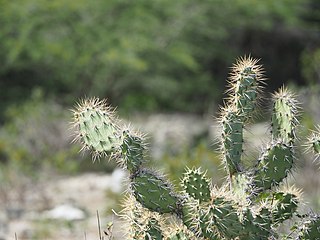
Stetsonia coryne, the toothpick cactus, is the sole species in the cactus genus Stetsonia. Stetsonia coryne is native to arid regions of South America, where it grows to a height of 15 to 25 ft tall. It contains mescaline and other alkaloids.

Echinocereus reichenbachii is a perennial plant and shrub in the cactus family. The species is native to the Chihuahuan Desert and parts of northern Mexico and the southern United States, where they grow at elevations up to 1,500 meters (4,900 ft). This cactus earned the Royal Horticultural Society's Award of Garden Merit.

Agave salmiana is a species of the family Asparagaceae, native to central and southern Mexico. It is also reportedly naturalized in South Africa, Italy and Spain, specially in the Canary Islands.

Echinocereus fendleri is a species of cactus known by the common names pinkflower hedgehog cactus and Fendler's hedgehog cactus. It is named in honor of Augustus Fendler.

Echinocereus viridiflorus is a species of cactus known by the common names nylon hedgehog cactus, green pitaya, and small-flowered hedgehog cactus. It is native to the central and south-central United States and northern Mexico, where it can be found in varied habitat types, including desert scrub, woodlands, dry grasslands, and short-grass prairie.

Ferocactus pilosus, also known as Mexican lime cactus or Mexican fire barrel, is a species of cactus in North America.

Soehrensia candicans is a species of cactus from northern and western Argentina. It has large fragrant white flowers that open at night.

Echinocereus dasyacanthus is a member of the cactus family, Cactaceae. It is one of about 2000 total species belonging to this family. The cactus is commonly known as Texas rainbow cactus because of the subtle rings or bands of contrasting colors along the stem of the plant. Not all Texas rainbow cacti have the "rainbow" coloration on their stems. Another common name is spiny hedgehog cactus.

Echinocereus stramineus is a species of cactus, with stramineus meaning made of straw. There are various common names such as strawberry cactus, porcupine hedgehog cactus, straw-color hedgehog, and pitaya. The straw-colored spines distinguishes this particular plant from other Echinocereus. The aged spines may turn white in color and are very fragile.

Echinocereus pentalophus, with the common name ladyfinger cactus, is a species of Echinocereus cactus, in the tribe Echinocereeae Tribe. It is native to North America.

Echinocereus berlandieri is a species of hedgehog cactus. Its range includes most of South Texas, and is commonly found along the Nueces River and the lower Rio Grande.

Echinocereus rigidissimus, commonly known as the Arizona rainbow cactus or rainbow hedgehog cactus, is a solitary-growing cactus that rarely branches or offsets with age.

Cochemiea goodridgei is a species of plant in the family Cactaceae. It is endemic to Mexican state Baja California.

Ferocactus pottsii is a species of Ferocactus from Mexico. The specific epithet has also been spelt pottsi.

Ferocactus haematacanthus is a species of Ferocactus from Mexico.

Echinopsis strigosa, is a species of Soehrensia in the cactus family. It is native to north western Argentina. It was first published in Cactaceae Syst. Init. 28: 31 in 2012.

Echinocereus scheeri is a species of hedgehog cactus in the family Cactaceae, native to northern Mexico. With its dramatic offsets, it has gained the Royal Horticultural Society's Award of Garden Merit.

Opuntia caracassana is a species from the genus Opuntia. The species was originally described by Joseph zu Salm-Reifferscheidt-Dyck in 1850.

Matucana haynii is a species of Matucana found in Peru.

Echinocereus russanthus is a species of cactus native to Texas and Mexico.




















